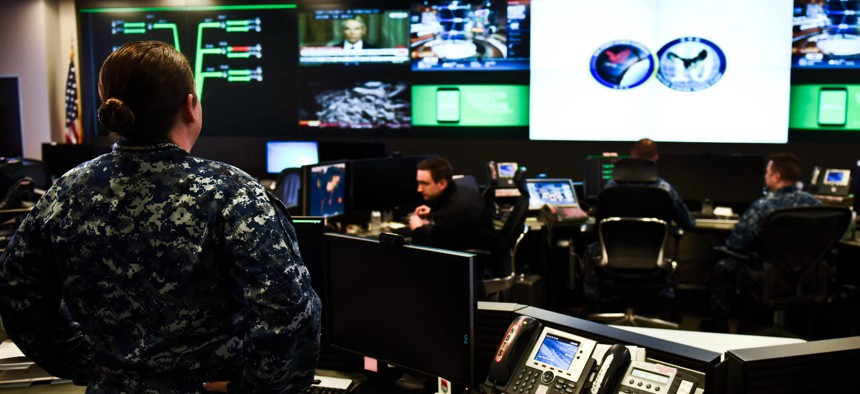Navy’s first cyber strategy looks beyond cybersecurity to digital operations

Sailors stand watch in the Fleet Operations Center at the headquarters of U.S. Fleet Cyber Command/U.S. MC1 Samuel Souvannason/U.S. Navy
The military branch must “fully account for new realities presented by cyberspace and the information environment,” the inaugural strategy asserts.
The U.S. Navy must embrace cyber and information warfare as “core competencies” of its strategic mission moving forward, according to the military branch’s inaugural cyber strategy released last week.
The 14-page document, which was released on Nov. 21, warned that the Navy and Marine Corps “cannot rely exclusively on traditional naval power in future maritime conflicts” and must “fully account for new realities presented by cyberspace and the information environment.”
The strategy said, in part, that “the side that most effectively sequences and synchronizes non-kinetic effects will have a decisive advantage” in future military confrontations.
“We are focused on aggressively enhancing our cyber enterprise, while fostering cooperation and collaboration with our allies and partners,” Secretary of the Navy Carlos Del Toro said in a statement.
The document outlined seven lines of effort to enhance the military branch’s cyber posture, including improving and supporting its cyber workforce; defending enterprise IT, data and networks; securing defense critical infrastructure and weapon systems; conducting and facilitating cyber operations; partnering with the private sector to secure the defense industrial base; and fostering cooperation and collaboration across the Navy and Marine Corps.
While the strategy cited efforts to bolster the branch’s IT systems and networks — such as developing “more robust threathunting capabilities” — it centered cyber and information warfare as key components of the Navy’s push to maintain a competitive advantage over global adversaries.
The guidance, in part, highlighted the Navy’s need to “focus time and resources” on training its workforce for cyberspace operations, including by providing personnel with cyber capabilities “for use in crisis and conflict” and contributing “to the development of emerging cyber warfighting platforms.”
“Our strategy reaffirms our commitment to warfighting excellence within cyberspace,” Chris Cleary, the Navy’s principal cyber advisor, said in a statement. “We are prioritizing the defense of our cyber enterprise and data while conducting and facilitating cyber operations across the globe.”
In an interview published in Defense One last week, Cleary — who stepped down from his position on Nov. 21 — stressed the difference between cyber and cybersecurity in the document.
"I can't overemphasize that this is not a cybersecurity strategy. This is a cyber strategy. This is a strategy that, when you look at the different lines of effort within it, goes well beyond the blocking and tackling of what the [chief information officer] is responsible for," Cleary said.
“Once we embrace cyber as a core competency alongside surface warfare, subsurface warfare, Marine expeditionary warfare, Navy special warfare — once cyber is seen in that lens as equal to the rest of these, things will then naturally begin to fall into place,” he added. “All indications are we're moving in that direction.”
The release of the Navy’s cyber strategy comes after the Pentagon submitted its classified cyber strategy to Congress in May. An unclassified summary of the department’s strategy was publicly released in September.



